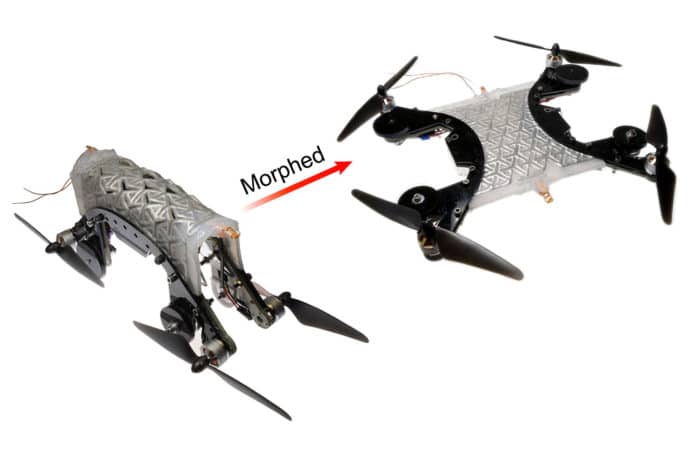A team of engineers at Virginia Tech has developed a soft robot that can morph into range shapes, such as a land vehicle, flying quadcopter, and swimming robot. The researchers use rubber, metal, and temperature to morph materials and fix them into place with no motors or pulleys.
To create a structure that could be morphed, the team turned to kirigami – the Japanese art of making shapes out of paper by cutting. By observing the strength of those kirigami patterns in rubbers and composites, the team was able to create a material architecture of a repeating geometric pattern.
Researchers needed a material that would hold shape but allow for that shape to be erased on demand. They introduced an elastomer endoskeleton cut in a kirigami pattern of triangles. Inside this material is a network of tubes containing a low melting point alloy (LMPA) embedded inside a rubber skin. Normally, when the metal is stretched too far, the metal becomes permanently bent, cracked, or stretched into a fixed, unusable shape. However, the researchers turned this typical failure mechanism into a strength with new special material embedded in the rubber.
When stretched, the new composite would now hold the desired shape rapidly, perfect for soft morphing materials that can become instantly load bearing. The metal inside in its liquid form can be bent and stretched into the desired shape for the robot. At this point, the metal hardens into a solid, keeping it in that shape.
After the task was complete, the material had to return the structure back to its original shape. For this, the team incorporated soft, tendril-like heaters next to the LMPA mesh that caused the metal to be converted to a liquid at 60 degrees Celsius. The elastomer skin keeps the melted metal contained in a place and then pulls the material back into the original shape. From there, it is ready to reshape for whatever it has to do next.
The shape changed and fixed into place in less than 1/10 of a second. In addition, the researchers found that if the material broke, it could be healed multiple times by melting and reforming the metal endoskeleton.
By combining this material with onboard power, control, and motors, the team created a functional drone that autonomously morphs from ground to air vehicle during the tests. They also created a small, deployable submarine, using the morphing and returning of the material to retrieve objects from an aquarium by scraping the belly of the sub along the bottom.
“We’re excited about the opportunities this material presents for multifunctional robots. These composites are strong enough to withstand the forces from motors or propulsion systems, yet can readily shape morph, which allows machines to adapt to their environment,” said Edward J. Barron, co-author of the paper.
The researchers envision the morphing composites playing a role in the emerging field of soft robotics to create machines that can perform diverse functions self-heal after being damaged to increase resilience, and spur different ideas in human-machine interfaces and wearable devices.
